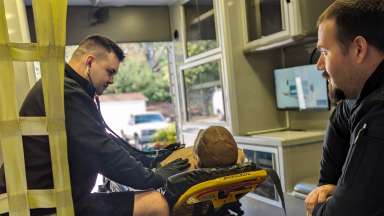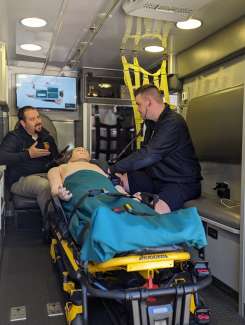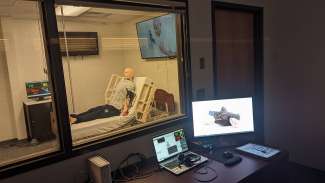When you think of a fire department’s work, you probably envision crews responding to fires and fire alarms. However, medical calls comprise 62 percent of Raleigh Fire Department’s call volume. Firefighters begin patient assessment and stabilization, usually before the ambulance arrives. All RFD firefighters are certified as emergency medical technicians (EMTs) and a small, but mighty team within the department ensures they are trained properly – and that they retain their skills.
The Raleigh Fire Department’s Emergency Medical Services team is responsible for the initial medical training and continuing education of the entire department – that’s about 600 EMTs. Team members teach the initial EMT course, which includes 240 hours and normally takes place during the Fire Academy that recruits complete before becoming firefighters. The team is also responsible for offering each EMT 20 hours of continuing education every year.
In their work the three members receive help from a group of firefighters of various levels who assist with the academy, continuing education, and simulation lab training. “Without them there is no way we could pull it all off,” says EMS Program Manager Jeff Stallings. “They often teach off-shift and each of these EMS instructors is certified by the state.”
Stallings’ team also oversee the recertification of each EMT through the North Carolina Office of EMS System. “The EMT credential must be renewed every four years, which is in line with other healthcare professions, such as nursing,” Stallings explains.
Patient Simulation Lab
The EMS team recently got a new tool that can significantly enhance training: a patient simulation lab.
The lab allows fire recruits the opportunity to practice what they learn, make mistakes – and learn from them – in a safe and supportive academic environment. The lab includes realistic-looking labs, three simulation mannequins, medical equipment, and technology.
“The experiential learning that happens in a sim lab prepares recruits for real-life emergency medical incidents without exposing actual patients to the potentially harmful mistakes of students as they are actively learning,” says Training Coordinator Kenneth Nichols.
For RFD members who are already operating in the field, the lab can re-enforce good practices. It also requires a standard of care that each provider must meet. Using the lab can help identify trends and implement training that addresses negative practices and reenforces positive trends in patient care.
Each of the lab’s three mannequins has its own special characteristics and actions ranging from a severed limb with uncontrolled bleeding to cardiac arrest, respiratory distress, and seizures.
Since RFD began using the lab earlier this year, EMTs have completed 640 simulations and the average time an EMT spent within a simulated scenario was a little more than nine minutes. “Along with each simulated scenario, crews spent on average 20 to 30 minutes talking about the scenario and related medical questions,” says Nichols.


